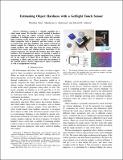| dc.contributor.author | Yuan, Wenzhen | |
| dc.contributor.author | Srinivasan, Mandayam A | |
| dc.contributor.author | Adelson, Edward H | |
| dc.date.accessioned | 2017-10-27T16:10:11Z | |
| dc.date.available | 2017-10-27T16:10:11Z | |
| dc.date.issued | 2016-12 | |
| dc.date.submitted | 2016-10 | |
| dc.identifier.isbn | 978-1-5090-3762-9 | |
| dc.identifier.issn | 2153-0866 | |
| dc.identifier.uri | http://hdl.handle.net/1721.1/111989 | |
| dc.description.abstract | Hardness sensing is a valuable capability for a robot touch sensor. We describe a novel method of hardness sensing that does not require accurate control of contact conditions. A GelSight sensor is a tactile sensor that provides high resolution tactile images, which enables a robot to infer object properties such as geometry and fine texture, as well as contact force and slip conditions. The sensor is pressed on silicone samples by a human or a robot and we measure the sample hardness only with data from the sensor, without a separate force sensor and without precise knowledge of the contact trajectory. We describe the features that show object hardness. For hemispherical objects, we develop a model to measure the sample hardness, and the estimation error is about 4% in the range of 8 Shore 00 to 45 Shore A. With this technology, a robot is able to more easily infer the hardness of the touched objects, thereby improving its object recognition as well as manipulation strategy. | en_US |
| dc.publisher | Institute of Electrical and Electronics Engineers (IEEE) | en_US |
| dc.relation.isversionof | http://dx.doi.org/10.1109/IROS.2016.7759057 | en_US |
| dc.rights | Creative Commons Attribution-Noncommercial-Share Alike | en_US |
| dc.rights.uri | http://creativecommons.org/licenses/by-nc-sa/4.0/ | en_US |
| dc.source | MIT Web Domain | en_US |
| dc.title | Estimating object hardness with a GelSight touch sensor | en_US |
| dc.type | Article | en_US |
| dc.identifier.citation | Yuan, Wenzhen et al. “Estimating Object Hardness with a GelSight Touch Sensor.” 2016 IEEE/RSJ International Conference on Intelligent Robots and Systems (IROS), October 9-14 2016, Daejeon, South Korea, Institute of Electrical and Electronics Engineers (IEEE), December 2016 © 2016 Institute of Electrical and Electronics Engineers (IEEE) | en_US |
| dc.contributor.department | Massachusetts Institute of Technology. Computer Science and Artificial Intelligence Laboratory | en_US |
| dc.contributor.department | Massachusetts Institute of Technology. Department of Brain and Cognitive Sciences | en_US |
| dc.contributor.department | Massachusetts Institute of Technology. Department of Electrical Engineering and Computer Science | en_US |
| dc.contributor.department | Massachusetts Institute of Technology. Department of Mechanical Engineering | en_US |
| dc.contributor.department | Massachusetts Institute of Technology. Laboratory for Human and Machine Haptics | en_US |
| dc.contributor.mitauthor | Yuan, Wenzhen | |
| dc.contributor.mitauthor | Srinivasan, Mandayam A | |
| dc.contributor.mitauthor | Adelson, Edward H | |
| dc.relation.journal | 2016 IEEE/RSJ International Conference on Intelligent Robots and Systems (IROS) | en_US |
| dc.eprint.version | Author's final manuscript | en_US |
| dc.type.uri | http://purl.org/eprint/type/ConferencePaper | en_US |
| eprint.status | http://purl.org/eprint/status/NonPeerReviewed | en_US |
| dc.date.updated | 2017-10-25T16:46:03Z | |
| dspace.orderedauthors | Yuan, Wenzhen; Srinivasan, Mandayam A.; Adelson, Edward H. | en_US |
| dspace.embargo.terms | N | en_US |
| dc.identifier.orcid | https://orcid.org/0000-0001-8014-356X | |
| dc.identifier.orcid | https://orcid.org/0000-0003-1347-6502 | |
| dc.identifier.orcid | https://orcid.org/0000-0003-2222-6775 | |
| mit.license | OPEN_ACCESS_POLICY | en_US |
